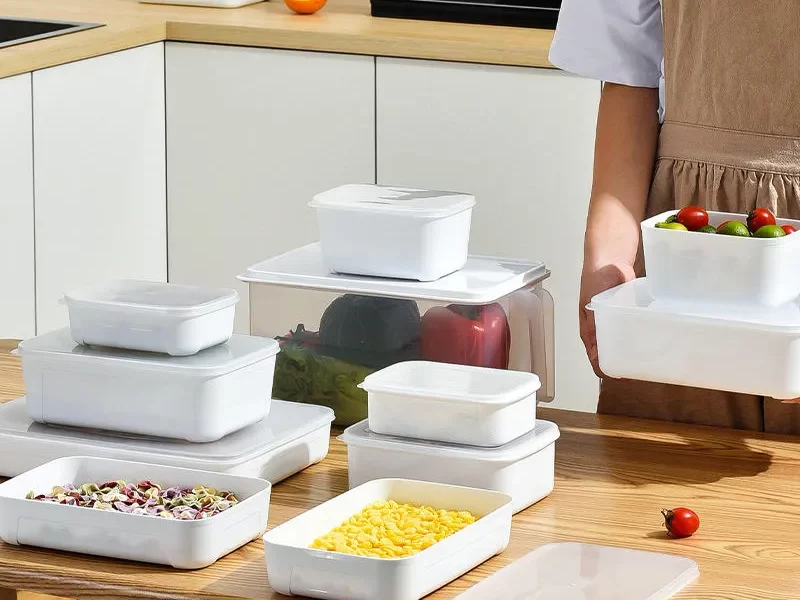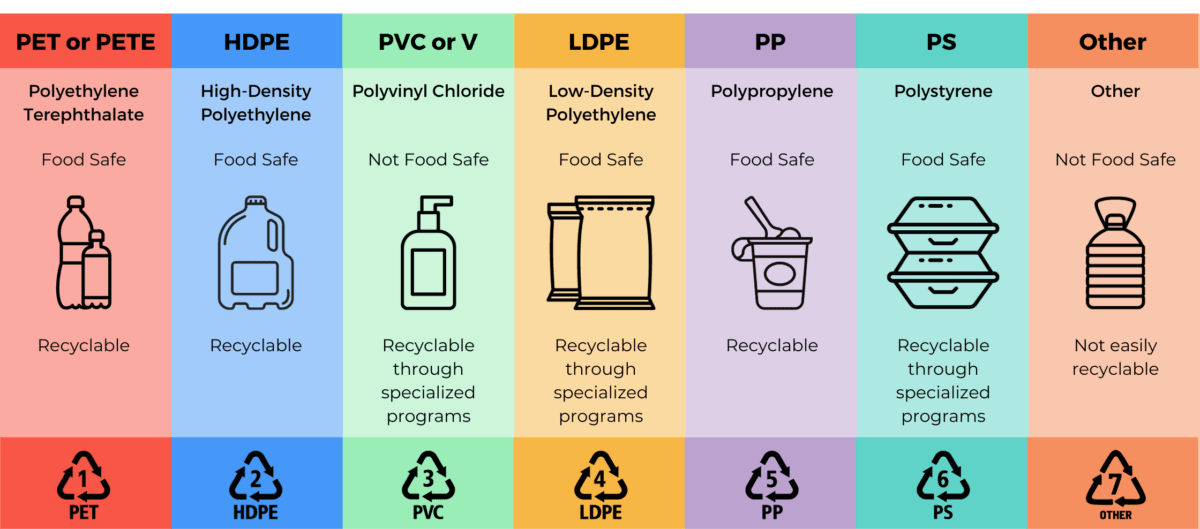
Kunststoff ist das weltweit am häufigsten verwendete Material zur Aufbewahrung von Lebensmitteln. Kunststoffbehälter sind leicht, preiswert und eignen sich perfekt für die Aufbewahrung von Lebensmitteln zu Hause oder in Restaurants. Trotz der vielen Vorteile von Kunststoffbehältern verwenden einige Unternehmen und Haushalte aufgrund von Fehlinformationen immer noch keine Kunststoffbehälter. Einem weit verbreiteten Irrtum zufolge glauben die Menschen beispielsweise, dass Kunststoffbehälter nicht für die Aufbewahrung von Lebensmitteln geeignet sind, weil sie schädliche Chemikalien wie BPA enthalten. Dies ist jedoch nicht der Fall.
Tatsächlich darf nur ein kleiner Teil des Kunststoffs Stoffe wie BPA enthalten, was an der Kennzeichnung der Lebensmittelqualität auf dem Kunststoffbehälter zu erkennen ist. In diesem Artikel wird ausführlich auf die Bedeutung der Lebensmittelqualität von Kunststoffen eingegangen und erläutert, welcher Kunststoffbehälter für die Aufbewahrung von Lebensmitteln am sichersten ist, damit Sie die Sicherheit von Lebensmitteln aus Kunststoff verstehen können.

Was bedeutet Lebensmittelqualität bei Kunststoffen?
Lebensmittelgeeignete Kunststoffe sind im Wesentlichen Kunststoffe, die als sicher für die Verwendung in Lebensmitteln gelten, z. B. für die Aufbewahrung von Lebensmitteln oder Besteck. Sie werden unter Einhaltung bestimmter Reinheitsstandards hergestellt, was bedeutet, dass bei ihrer Herstellung keine Materialien verwendet werden, die ein Risiko für die menschliche Gesundheit darstellen könnten. Um als lebensmitteltauglich zu gelten, müssen Kunststoffbehälter bestimmte Vorschriften erfüllen, z. B. frei von Zusatzstoffen, Farbstoffen und anderen schädlichen Produkten sein.

Kunststoffbehälter sind auf der Unterseite mit einer Lebensmitteleinstufung von 1 bis 7 gekennzeichnet. Dies gibt den Verbrauchern eine Vorstellung davon, wie sicher der Kunststoff für die Lagerung von Lebensmitteln ist. Lebensmittelgeeigneter Kunststoff muss den Vorschriften entsprechen. Er darf keine Farbstoffe, Zusatzstoffe oder andere schädliche Produkte enthalten. Lebensmittelechter Kunststoff kann recycelte Materialien enthalten, die jedoch die entsprechenden Richtlinien erfüllen müssen. Die Food and Drug Administration ist dafür zuständig, zu bestimmen, wie sich Materialien verhalten, wenn sie mit Lebensmitteln in Kontakt kommen.
Einführung in Kunststoffe der Klassen 1-7
Nummer 1: PET oder PETE - Dieser Kunststoff, Polyethylenterephthalat, wird als Nummer 1 auf dem Recycling-Dreieck aufgeführt. PET-Kunststoff ist klar, zäh und resistent gegen Gase und Feuchtigkeit. Dieser Kunststoff wird häufig für Getränke wie Softdrinks, Säfte und abgefülltes Wasser verwendet. Er wird auch in Lebensmitteln wie Erdnussbutter, Essiggurken und Salatdressings verwendet.
Nummer 2: HDPE - Polyethylen hoher Dichte ist ein Kunststoff, der häufig für Milchflaschen, einige Saftbehälter und Wäscheprodukte verwendet wird. Er erscheint als Nr. 2 auf dem Dreieckskode. Diese Behälter können durchsichtig oder farbig sein, sind einigermaßen starr und eignen sich ideal für die Verpackung von Produkten mit kurzer Haltbarkeit, wie z. B. Milch.
Nummer 3: PVC - Bei dem Begriff PVC (Polyvinylchlorid) denken die meisten Menschen an Kunststoffrohre. Der Dreieckscode enthält die Nummer 3. Dieser Kunststoff ist witterungsbeständig und wird für elektrische Leitungen im Haus verwendet, und er ist das Hauptmaterial für Fensterrahmen, Bodenfliesen und Verkleidungen in Häusern. Dieser Kunststoff kann sowohl für Lebensmittel als auch für andere Zwecke verwendet werden. Bevor Sie Lebensmittel in einem Behälter aufbewahren, vergewissern Sie sich, dass der Behälter nicht für industrielle oder bauliche Zwecke behandelt worden ist.
Nummer 4: LDPE - Kunststoffe aus Polyethylen niedriger Dichte sind als Nummer 4 im Dreieckscode aufgeführt. Sie werden in einer Vielzahl von Produkten verwendet, z. B. in Beuteln für die chemische Reinigung, in Beuteln für Brot und Tiefkühlkost sowie in ausquetschbaren Flaschen für Senf und Honig. Bei der Wiederverwertung für die Aufbewahrung von Lebensmitteln ist darauf zu achten, in welchen Behältern sie vorher verwendet wurden und wie leicht sie sterilisiert werden können. Für die langfristige Lagerung von Lebensmitteln ist dieser Kunststoff nicht unbedingt geeignet.
Nummer 5: PP - Polypropylen ist mit der Nummer 5 im Dreieckscode gekennzeichnet. Dieser Kunststoff ist zäh und kann hart oder flexibel sein. Joghurtbecher, Margarinebecher und Arzneimittelflaschen sind Beispiele für lebensmitteltaugliche Behälter aus diesem Kunststoff. Polypropylen wird auch zur Herstellung von Eisschaufeln, Öltrichtern, Harken, Schalen und Kühlschrankaufbewahrungsbehältern für Lebensmittel verwendet. Es ist ein weit verbreiteter Kunststoff.
Nummer 6: PS - Das ist Polystyrol, das im Recycling-Dreieck mit der Nummer 6 gekennzeichnet ist. Es handelt sich um einen starren Kunststoff oder Schaumstoff, der klar, hart und spröde ist. Typische Verwendungszwecke sind Becher, Teller, Besteck, Eierkartons, Fleischschalen und Compact-Disc-Hüllen. Es wird zwar häufig für Verpackungen verwendet, aber in der Regel nicht für Behälter, die zur Lagerung von Lebensmitteln geeignet sind.
Nummer 7: Die letzte Kategorie ist Nummer 7. Dieser Code zeigt an, dass die Verpackung aus einem anderen als den sechs oben genannten Harzen oder aus einer Kombination von zwei oder mehr dieser Harze besteht. Bei Lebensmitteln und Lebensmittellagerung werden Behälter mit der Nummer 7 üblicherweise für wiederverwendbare 3-Gallonen- und 5-Gallonen-Wasserflaschen/-krüge, einige Zitrussaftbehälter und Ketchupflaschen verwendet.
Welche Kunststoffnummern sind für die Lagerung von Lebensmitteln geeignet?
| KUNSTSTOFFNUMMER | KUNSTSTOFF | SICHER FÜR LEBENSMITTEL? | ANWENDUNG |
| 1 | PET | Ja | Flaschen für den einmaligen Gebrauch |
| 2 | HDPE | Ja | Saft- und Milchkannen |
| 3 | PVC | Nein | Rohre, Schläuche und Dichtungen |
| 4 | LDPE | Ja | Brot- und Gemüsebeutel |
| 5 | PP | Ja | Medikamentenflaschen, Vorratsdosen für Lebensmittel |
| 6 | PS | Nein | Plastikbesteck, Kaffeebecher |
| 7 | Andere Kunststoffe | Ja | Babyflaschen, Wasserflaschen |
Nachdem wir nun die einzelnen Kunststoffe und ihre Verwendungszwecke aufgeschlüsselt haben, können die Kunststoffe mit den Nummern 2, 4 und 5 für die Aufbewahrung von Lebensmitteln verwendet werden. Dazu gehören die Materialien HDPE, LDPE und PP; in diesen Behältern können Lebensmittel gelagert werden, ohne dass giftige Chemikalien austreten. Nummer 5, PP-Material, ist die beste Wahl für die Lagerung von Lebensmitteln. Kunststoff mit der Nummer 1 ist nur dann sicher, wenn er einmal verwendet wird und nicht dem direkten Sonnenlicht ausgesetzt ist. Vermeiden Sie die Verwendung von Kunststoffen der Nummern 3 und 6.
Fazit
Da das Bewusstsein für Giftstoffe in Kunststoffen wächst, ist es wichtig zu wissen, wie man Lebensmittel sicher aufbewahrt. Mit den richtigen Lebensmittelbehältern wird verhindert, dass schädliche Bakterien und Giftstoffe in den Körper gelangen. Dies kann ernsthafte Gesundheitsprobleme verhindern und den Planeten durch die Verwendung erneuerbarer Materialien umweltfreundlicher machen.
Entgegen einem weit verbreiteten Irrglauben ist Kunststoff im Allgemeinen sicher, wenn es um die Aufbewahrung von Lebensmitteln geht. Wählen Sie das richtige Material für Lebensmittelbehälter aus Kunststoff, um sicherzustellen, dass Ihre Kunststoffbehälter sicher für die Verwendung von Lebensmitteln sind.


Wenn Sie auf der Suche nach den sichersten und hochwertigsten Kunststoffbehältern sind, LEBO ist der Lieferant für Kunststoffbehälter, den Sie suchen! Wir bieten eine breite Palette von Qualität und erschwinglich Großhandel Lebensmittel Lagerung Containervon Vorratsbehältern für trockene Lebensmittel bis hin zu Lebensmittelbehältern für den Kühlschrank. Unsere beliebtesten Großhandel Kunststoff-Lebensmittel-Container sind speziell aus PP-Material hergestelltSo können Sie sich der Qualität und Sicherheit der Produkte sicher sein.
Schauen Sie sich unser komplettes Angebot an und nehmen Sie Kontakt mit uns auf, um mehr über unsere Produkte zu erfahren.
